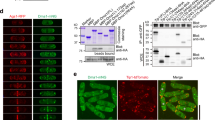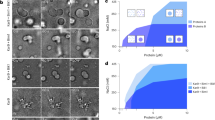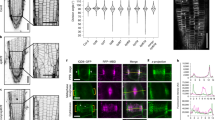Abstract
Microtubules have a central role in eukaryotic cell polarity1, in part through interactions between microtubule end-binding proteins and the cell cortex2,3. In the fission yeast Schizosaccharomyces pombe, microtubules and the polarity modulator tea1p maintain cylindrical cell shape and strictly antipodal cell growth4,5,6,7. The tea1p protein is transported to cell tips by association with growing microtubule plus ends8; once at cell tips, tea1p releases from microtubule ends and associates with the cell cortex, where it coordinates polarized growth4,6. Here we describe a cortical protein, mod5p, that regulates the dynamic behaviour of tea1p. In mod5Δ cells, tea1p is efficiently transported on microtubules to cell tips but fails to anchor properly at the cortex and thus fails to accumulate to normal levels. mod5p contains a signal for carboxy-terminal prenylation and in wild-type cells is associated with the plasma membrane at cell tips. However, in tea1Δ cells, although mod5p remains localized to the plasma membrane, mod5p is no longer restricted to the cell tips. We propose that tea1p and mod5p act in a positive-feedback loop in the microtubule-mediated regulation of cell polarity.
This is a preview of subscription content, access via your institution
Access options
Subscribe to this journal
Receive 51 print issues and online access
$199.00 per year
only $3.90 per issue
Buy this article
- Purchase on Springer Link
- Instant access to full article PDF
Prices may be subject to local taxes which are calculated during checkout




Similar content being viewed by others
References
Drubin, D. G. & Nelson, W. J. Origins of cell polarity. Cell 84, 335–344 (1996)
Schuyler, S. C. & Pellman, D. Microtubule ‘plus-end-tracking proteins’: The end is just the beginning. Cell 105, 421–424 (2001)
Gundersen, G. G. Evolutionary conservation of microtubule-capture mechanisms. Nature Rev. Mol. Cell Biol. 3, 296–304 (2002)
Mata, J. & Nurse, P. tea1 and the microtubular cytoskeleton are important for generating global spatial order within the fission yeast cell. Cell 89, 939–949 (1997)
Sawin, K. E. & Nurse, P. Regulation of cell polarity by microtubules in fission yeast. J. Cell Biol. 142, 457–471 (1998)
Hayles, J. & Nurse, P. A journey into space. Nature Rev. Mol. Cell Biol. 2, 647–656 (2001)
Chang, F. Establishment of a cellular axis in fission yeast. Trends Genet. 17, 273–278 (2001)
Behrens, R. & Nurse, P. Roles of fission yeast tea1p in the localization of polarity factors and in organizing the microtubular cytoskeleton. J. Cell Biol. 157, 783–793 (2002)
Browning, H. et al. Tea2p is a kinesin-like protein required to generate polarized growth in fission yeast. J. Cell Biol. 151, 15–28 (2000)
Brunner, D. & Nurse, P. CLIP170-like tip1p spatially organizes microtubular dynamics in fission yeast. Cell 102, 695–704 (2000)
Adachi, Y., Toda, T., Niwa, O. & Yanagida, M. Differential expressions of essential and nonessential alpha-tubulin genes in Schizosaccharomyces pombe. Mol. Cell. Biol. 6, 2168–2178 (1986)
Tran, P. T., Marsh, L., Doye, V., Inoue, S. & Chang, F. A mechanism for nuclear positioning in fission yeast based on microtubule pushing. J. Cell Biol. 153, 397–411 (2001)
Ding, D. Q., Chikashige, Y., Haraguchi, T. & Hiraoka, Y. Oscillatory nuclear movement in fission yeast meiotic prophase is driven by astral microtubules, as revealed by continuous observation of chromosomes and microtubules in living cells. J. Cell Sci. 111, 701–712 (1998)
Drummond, D. R. & Cross, R. A. Dynamics of interphase microtubules in Schizosaccharomyces pombe. Curr. Biol. 10, 766–775 (2000)
Zhang, F. L. & Casey, P. J. Protein prenylation: Molecular mechanisms and functional consequences. Annu. Rev. Biochem. 65, 241–269 (1996)
Arellano, M., Niccoli, T. & Nurse, P. Tea3p is a cell end marker activating polarized growth in Schizosaccharomyces pombe. Curr. Biol. 12, 751–756 (2002)
Bahler, J. & Pringle, J. R. Pom1p, a fission yeast protein kinase that provides positional information for both polarized growth and cytokinesis. Genes Dev. 12, 1356–1370 (1998)
Glynn, J. M., Lustig, R. J., Berlin, A. & Chang, F. Role of bud6p and tea1p in the interaction between actin and microtubules for the establishment of cell polarity in fission yeast. Curr. Biol. 11, 836–845 (2001)
Bienz, M. The subcellular destinations of APC proteins. Nature Rev. Mol. Cell Biol. 3, 328–338 (2002)
Miller, R. K., Cheng, S. C. & Rose, M. D. Bim1p/Yeb1p mediates the Kar9p-dependent cortical attachment of cytoplasmic microtubules. Mol. Biol. Cell 11, 2949–2959 (2000)
Lee, L. et al. Positioning of the mitotic spindle by a cortical-microtubule capture mechanism. Science 287, 2260–2262 (2000)
Korinek, W. S., Copeland, M. J., Chaudhuri, A. & Chant, J. Molecular linkage underlying microtubule orientation toward cortical sites in yeast. Science 287, 2257–2259 (2000)
Akhmanova, A. et al. Clasps are CLIP-115 and -170 associating proteins involved in the regional regulation of microtubule dynamics in motile fibroblasts. Cell 104, 923–935 (2001)
Fukata, M. et al. Rac1 and Cdc42 capture microtubules through IQGAP1 and CLIP-170. Cell 109, 873–885 (2002)
Tirnauer, J. S., Grego, S., Salmon, E. D. & Mitchison, T. J. EB1-microtubule interactions in Xenopus egg extracts: role of EB1 in microtubule stabilization and mechanisms of targeting to microtubules. Mol. Biol. Cell 13, 3614–3626 (2002)
Komarova, Y. A., Akhmanova, A. S., Kojima, S., Galjart, N. & Borisy, G. G. Cytoplasmic linker proteins promote microtubule rescue in vivo. J. Cell Biol. 159, 589–599 (2002)
Kirschner, M. & Mitchison, T. Beyond self-assembly: from microtubules to morphogenesis. Cell 45, 329–342 (1986)
Moreno, S., Klar, A. & Nurse, P. Molecular analysis of the fission yeast Schizosaccharomyces pombe. Methods Enzymol. 194, 795–823 (1991)
Bahler, J. et al. Heterologous modules for efficient and versatile PCR-based gene targeting in Schizosaccharomyces pombe. Yeast 14, 943–951 (1998)
Woods, A. et al. Definition of individual components within the cytoskeleton of Trypanosoma brucei by a library of monoclonal antibodies. J. Cell Sci. 93, 491–500 (1989)
Acknowledgements
We thank members of the Wellcome Trust Centre for Cell Biology for discussions, and R. Allshire, I. Davis, W. Earnshaw and H. Ohkura for critical reading of the manuscript. This work was supported by a Wellcome Trust Senior Research Fellowship to K.E.S. H.A.S. is currently a Caledonian Research Foundation Post-doctoral Fellow.
Author information
Authors and Affiliations
Corresponding author
Ethics declarations
Competing interests
The authors declare that they have no competing financial interests.
Supplementary information
Rights and permissions
About this article
Cite this article
Snaith, H., Sawin, K. Fission yeast mod5p regulates polarized growth through anchoring of tea1p at cell tips. Nature 423, 647–651 (2003). https://doi.org/10.1038/nature01672
Received:
Accepted:
Issue Date:
DOI: https://doi.org/10.1038/nature01672
This article is cited by
-
Multivalent interactions facilitate motor-dependent protein accumulation at growing microtubule plus-ends
Nature Cell Biology (2023)
-
Ubiquitination of CLIP-170 family protein restrains polarized growth upon DNA replication stress
Nature Communications (2022)
-
Genetically shaping morphology of the filamentous fungus Aspergillus glaucus for production of antitumor polyketide aspergiolide A
Microbial Cell Factories (2014)
-
Spatial segregation of polarity factors into distinct cortical clusters is required for cell polarity control
Nature Communications (2013)
-
Calcineurin ensures a link between the DNA replication checkpoint and microtubule-dependent polarized growth
Nature Cell Biology (2011)
Comments
By submitting a comment you agree to abide by our Terms and Community Guidelines. If you find something abusive or that does not comply with our terms or guidelines please flag it as inappropriate.



